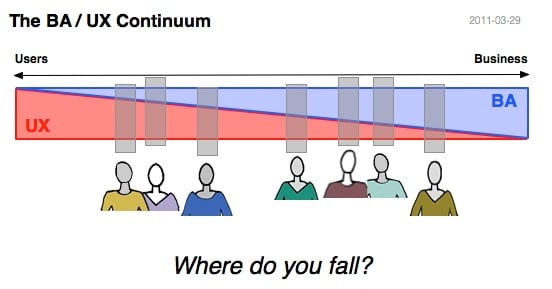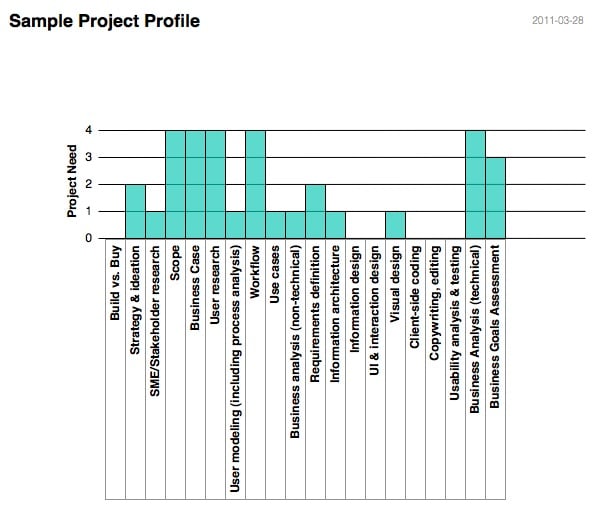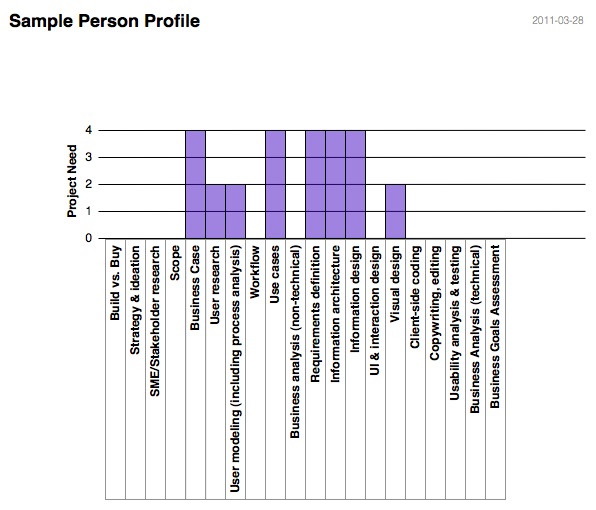At UC Berkeley there has been an increasing awareness of the importance of business analysis (BA) and user experience (UX) in the software development lifecycle. In this article we will discuss the advantages of involving BA and UX practitioners in your development process, when and how to involve them, and the similarities and differences between the two professions.
Software is changing
All around us, information technology is changing and it is changing our lives. What we touch and what touches us is increasingly dynamic, contextual, and personalized. As we move through the world there are services and devices that tell us when friends are nearby, which movies are about to start, and when those coveted shoes go on sale.
IT is changing at Berkeley too. We expect to be informed if a meeting location changes or when timesheets are due. However, many data-driven processes still require human attention because of incompatible systems or obscure data stores. While we all muddle through somehow, we could be more efficient and effective if some of the gaps -- both human and technical -- were bridged. There is broad consensus on campus to do this, but the exact path is not clear. We have a great deal of technical expertise, but often have not given enough weight to the more human or functional side of IT -- which may also be thought of as "analysis" or "design thinking." In this context, design is less a visual or asthetic process and more similar to engineering: "a vigorous approach to solving problems, identifying new opportunities, and creating great solutions."[1] Design thinking is used extensively in successful software companies such as Google, Apple, Intuit, and Autodesk. For these companies, it is clear that incorporating design earlier in the development process improves business outcomes.
The cost to organizations that neglect up-front analysis has been documented in a 2009 study by IAG Consulting. "IAG found poor requirements definition and management consume over one-third of IT's application development budget." Companies that were defined as having a low level of requirements maturity "failed to achieve their business objectives on almost half their projects, while taking 35 percent more time to complete them."[2]
We have two disciplines on campus that extensively apply analysis and design thinking to the product development process: business analysis and user experience. Because these disciplines are underrepresented on campus, an Operational Excellence proposal was submitted recently to increase BA-UX capabilities and resources. These practitioners can help teams "bring better balance to the demand-design-delivery process by shifting resources from a focus on implementing technology to a focus on understanding and solving the most important problems."[3]
While skilled BA-UX practitioners are in short supply at Berkeley, an army of design thinkers would not help us today because of a lack of understanding about the contributions they can make and how they can best be integrated into development teams. This article is intended to address these issues.
We need new skills for the new projects
“It's not what you're called, it's what you do.” -- Modern Analyst [4]
Business analysts (BA) and user experience (UX) practioners both employ analysis and design thinking to bridge the gaps between business needs, user needs and technology. While BA and UX practioners may have diverse titles such as user experience designer, business process analyst, systems analyst, information architect, functional analyst, usability specialist, or even product manager, their importance is not in their titles but in the competencies they bring to their projects.
BA and UX skill sets overlap more than they diverge. Traditionally BAs are thought to have more of a business, or stakeholder, focus and UX practitioners are thought to have more of a user focus. However, in practice neither can work in a silo: BAs must think about user needs, and UX practitioners must consider business needs. In fact, Ian Crew of IS&T Data Services who has worked with both UX & BA practitioners at Berkeley says, "To be successful at either BA or UX, you have to know a lot about the other."
It may be easiest to think of BA and UX at Berkeley on a continuum:

BA and UX are positions on a continuum with related goals. The skill sets overlap substantially. In our own work [5] as well as the work of others [6][7] we've seen them merged into a single title: BA-UX. It may make less sense to focus a BA or UX practitioner's label than to consider where they fall on the continuum. How much does this particular practitioner focus on users vs. the business? Or do they hold the big picture?
The BA and UX skill sets include:

While not every practitioner will have all of these competencies, not every project will need all of them or may need them in varied proportions. Depending on the practitioner's competencies and how they apply them based on the needs of the project, a BA-UX practitioner may fall more to one side or the other of the continuum. However, they can both work on strategy, product definition, and requirements--which are all essential up-front activities for any software development project.
Each practice tends to have specialities that distinguish it from the other. BAs often specialize in requirements management or business process analysis and improvement. They may also write business cases, do data modeling or analysis, or perform detailed technical analysis. BAs may conduct deep analysis in one of these topic areas, while a UX practitioner's focus is usually more broad. UX practitioners often specialize in user research and the creation of user models such as personas and scenarios. Interaction design and usability testing are also primarily the responsibility of the UX practitioner.

How can BA-UX improve my Project?
When beginning a project it is critical to have the right team assembled to do the job. A project may not succeed if the team doesn't have the right skills, and most software development projects at Berkeley need some level of BA-UX input. However, the skill level of a BA-UX practitioner can vary by project size; not all projects require highly skilled senior BA-UX practitioners. There also are varying levels of engagement that may be appropriate, from a part-time BA-UX advisor who works with the project team to having multiple BA & UX practitioners on the team. Additionally, some projects may need more help on the BA side of the continuum and others may need more help on the UX side.
To create useful and usable software and websites, the industry[8] and academically[9] proven approach is to involve BA-UX practitioners from inception to completion of a project. Ideally, especially for large, enterprise-level projects, a BA-UX practitioner should be involved even prior to the project proposal to formulate and/or vet the project idea. They should be given enough time to do any research necessary to ensure that the project will meet business objectives and be helpful to its intended end users. This may at times result in changing the direction of a project, which can save the investment of time and money in the wrong project.
When determining how much BA-UX input your project needs, consider the number of users, the impact of the system on their productivity, and its criticality to the university. For large projects or projects that are critical to the university, we recommend that at least one BA-UX practitioner is designated as a member of the team at the very beginning to participate in the initial strategy and project planning. For smaller or less mission-critical applications or websites, at a minimum we recommend that a senior-level BA-UX practitioner be consulted at the beginning of a project to give input on what BA & UX activities are integral or recommended for the project. Even in smaller projects it may be appropriate to employ a junior-level BA-UX practitioner, who consults with a senior practitioner about what BA-UX practices to apply.
When selecting a BA-UX practitioner or practitioners for your project, it can be helpful to create a project profile illustrating how much of each of the various BA-UX activities your project needs:

You can then compare your project profile to those of the available BA-UX practitioners to determine if they are the right fit for your project:

Paths to broaden and deepen: Options for Aspiring BA-UX Practitioners
Degree and Certificate Programs
Bentley University
Certificate offered: UX
Carnegie Mellon University School of Computer Science Human-Computer Interaction Institute
Degrees offered: MS, PhD
California State University, Fullerton
Degree offered: Masters in Instructional Design & Technology
California State University, Fullerton Extension
Certificate offered: User Experience and Usability certificate program
Human Factors International
Certificates offered: Certified Usability Analyst, Certified User Experience Analyst
Indiana University, School of Informatics and Computing Human-computer interaction Design Program
Degrees offered: MS, PhD
Rutgers
Degree offered: Mini-Masters in User Experience Design
Savannah College of Art and Design
Undergraduate Minor offered: Interaction Design
Stanford University Design Program
Stanford University Institute of Design
University of California, Berkeley School of Information
Degrees offered : Masters, PhD
University of California, Berkeley Berkeley Institute of Design
University of California, Berkeley Extension
Certificate offered: Business Analysis certificate program
University of California, Santa Cruz Extension in Cupertino
Certificate offered: Web Design Certificate Program - includes classes on UCD, UX design & user research
University of Michigan School of Information
Degrees offered: Masters, PhD
University of Washington Department of Human Centered Design & Engineering (HCDE)
Degrees offered: BS, MS, PhD
Certificates offered: User-Centered Design
Online Resources
Events
Many of the organizations listed above also offer events and conferences. Here are some additional event opportunities:
Sources
[1] MIT's Technology Review: Design Fundamentals
[2] Enterprise Systems Journal: Wasted IT Development Spending
[3] UC Berkeley iNews: OE Information Technology Initiative update
[4] Modern Analyst: BA Definition
[5] Opencast Matterhorn Project: Business Analysis and User Experience Activities
[6] Keith Instone: BA UX
[7] Challis Hodge: BA UX
[8] Journal of Usability Studies: Adapting Usability Investigations for Agile User-Centered Design
[9] Berkeley's iSchool faculty Nancy Van House and Tapan Parikh: User Experience lecture at the iSchool Integrative Workshop, Spring 2011
Authors: Allison Bloodworth is a Senior User Experience Designer at the University of California, Berkeley. She is currently working on Berkeley's Sakai OAE implementation and an online course evaluation system. Allison has worked on the Fluid Project (http://www.fluidproject.org/) and Opencast Matterhorn (http://www.opencastproject.org/project/matterhorn) as well as numerous campus projects, from a faculty achievement and review system to to the UC Berkeley Calendar Network (http://events.berkeley.edu). She uses user-centered design techniques to create delightful user experiences, and educates others about how to apply them to their projects. In May 2004 Allison graduated from UC Berkeley's School of Information with a Masters in Information Management & Systems.
James Dudek is a Business Systems Analyst at the University of California, Berkeley. He has worked as a BA on a number of student systems projects. Most recently he served on the analysis team for the Kuali Student development effort. He co-founded the staff Business Process Analysis Working Group (BPAWG) - a community of practice which meets monthly on topics of interest for campus analysts and project managers.
Rachel Hollowgrass is a User Experience Architect at the University of California, Berkeley. She is working on Berkeley's Sakai OAE implementation to bring modern and integrated curricular, collaborative and administrative functionality to Berkeley's students, staff and faculty. Rachel and Allison collaboratively facilitate the campus User-Centered Design group, a community of practice that meets monthly about all things related to user-centered design and user experience.